The Biology Department at Luther College is housed in Sampson Hoffland Laboratories and east wing of Valders Hall of Science. Biology facilities include:
- 13 teaching labs which connect to research labs for collaborative faculty-student research
- teaching and research storage areas
- 14 faculty offices
- more than 4,800 square feet of student study space
The Biology Department provides excellent support facilities for teaching and student research, including a new greenhouse, microscopy facility, natural history collections, and diverse on-campus natural areas.
Students can use these facilities for their research. They may:
- search for developmental mutants in the greenhouse
- analyze hormone levels of athletes to assess the effects of training
- investigate biofilm formation in bacteria using a scanning laser confocal microscope
- study the effect of prairie reconstruction on biodiversity
Luther College Natural Areas
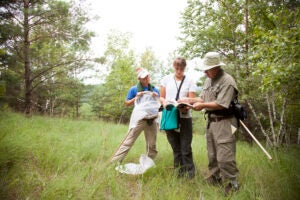 Northeastern Iowa, along the Upper Iowa River, is a natural draw for biologists. Known as the Driftless Area, this part of the Upper Midwest escaped the most recent glaciation. It features rugged topography with a great variety of natural habitats.
Northeastern Iowa, along the Upper Iowa River, is a natural draw for biologists. Known as the Driftless Area, this part of the Upper Midwest escaped the most recent glaciation. It features rugged topography with a great variety of natural habitats.
The areas that surround campus are a vital component of students’ education in biology. Because of their easy accessibility, many of the natural areas are used by students each year for field “labs.” The diversity of habitats and ongoing restoration projects provide many opportunities for student research projects.
Hiking Trails
Students and the public have access to a five-mile trail that connects each of the areas described below, as featured in this color map. A black and white version is also available with detailed descriptions.
Woodlands
Spilde Woods and Hickory Ridge Woods are mature hardwood forests with several species of oak, hickories, walnuts, and maples. They are used by students in biology classes to study forest ecology. In the early spring, blue bells, Hepatica, and spring beauty are common on the forest floor.
Roslien Woodlands is a former pasture that was planted to hardwoods and conifers to restore the soils. The conifers are being removed as the hardwoods grow larger.
The Weigle-Roslien Woodland is a 10-acre tract of old sugar maple-dominated forest donated to the college by Luther emeriti professors James Weigle and David Roslien. Located about 10 miles north of campus, this is a rare remnant of Big Woods vegetation on rich soils. Students studying ecology and botany have participated in establishing permanent research plots to study long-term changes in vegetation at this site.
River and Floodplain
The Upper Iowa River runs through the Luther College property. The Invertebrate Zoology course monitors benthic macroinvertebrates within the river.
Hoslett Study Area is located along the Upper Iowa River and has an interesting mix of plant species adapted to rich floodplain soils. Funds from the Emergency Watershed Protection program allowed Luther College to restore additional land along the Upper Iowa River Floodplain. In 2011, native trees and prairie species were planted. Students will be involved in monitoring the progress of the ecological restoration of these areas for years to come.
Lindeman Pond is one of several ponds on campus used by students in biology courses. Named after Raymond Lindeman, who developed the energy flow model for ecosystems based on his research at Cedar Creek bog in Minnesota. The pond has painted and snapping turtles, spring peepers, and bluegill, as well as microscopic organisms studied by microbiology students.
Prairies
Anderson Prairie is a 24.7-acre planted tallgrass prairie that prior to 1988 was used for row-crop agriculture by the college farm. Planted in 1988 and expanded in 1998, the goal was to reduce soil erosion, increase biodiversity, and provide increased educational and research opportunities for our students.
Gateway Prairie is a 39.3-acre prairie and oak savanna established in 2005 along the east side of Highway US-52 immediately adjacent to the Upper Iowa River, with the goal of helping reduce soil erosion during flood events and providing recreational and aesthetic benefits to the Decorah community. Formerly a highly erodable agricultural field, the prairie was planted with over 70 species of native plants. Burn breaks within the prairie are used by the cross country team as part of their race courses.
Jewell Prairie, Aikman Prairie, West-River Prairie are sites where students in several biology and environmental studies courses learn about prairie ecology.
Remote Natural Areas
Lionberger Environmental Preserve is a 176-acre site that includes an upland oak-hickory forest, Ten Mile Creek, a spring-fed pond, a floodplain forest, several open grassland areas, and limestone bluff outcrops. Located 5 miles west of campus at 2413 Pole Line Road. Students in the Botany, Ecology, Entomology and geology courses regularly use this area for field studies.
Freeport Marsh is an unusually large spring-fed marsh with several plant species that are rare in Iowa; including skunk cabbage, alder, and sweet flag.
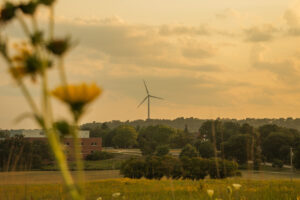 Historically, over 80% of the state of Iowa was tallgrass prairie, yet today less than 0.1% of that endangered ecosystem still exists. To combat this loss, tallgrass prairies such as Anderson Prairie have been planted to return some of the environmental benefits and biodiversity of the historic grassland ecosystem to the landscape.
Historically, over 80% of the state of Iowa was tallgrass prairie, yet today less than 0.1% of that endangered ecosystem still exists. To combat this loss, tallgrass prairies such as Anderson Prairie have been planted to return some of the environmental benefits and biodiversity of the historic grassland ecosystem to the landscape.
Site Description
Anderson Prairie is a 24.7 acre tallgrass prairie planting (Figure 1) located on the northeastern edge of the Luther College campus in Decorah, Winneshiek Co., Iowa (43.315° N, 91.799° W). The prairie borders a mixed hardwood forest (Hickory Ridge Woods) to the northeast, consisting predominantly of bur oak, shagbark hickory, and red cedar trees. Located to the southeast (Ridge Road) and to the northwest of the prairie are residential areas, while to the southwest is College Drive and the main campus. The mean annual temperature (1893-1993) is 7.4°C (45.3°F), and mean annual precipitation is 808.7 mm (31.8”). Soils within Anderson Prairie range from sand to a sandy loam.
History of Anderson Prairie
Prior to 1988, the site was used for row crop agriculture by the college farm.
In May 1988 the “sloped” northeastern half of the prairie was planted with a mix of 4 native grass species and a light mix of 9 native forbs when the field was entered into the CRP program to reduce severe erosion problems. Anderson Prairie was dedicated by the Board of Regents on November 11, 1995 to honor of Jutta F. and H. George Anderson, the wife and President of the College who enjoyed walking through the prairie in the early 90s.
In 1994, burn breaks subdividing the prairie into management plots were established, and these regularly mowed trails are used heavily for recreational and management use. Anderson Prairie is currently divided into 19 separate research plots where various management treatments are implemented. Treatments within the prairie include plots mowed every other year to mimic grazing, and plots burned with spring burns on 1, 2, 3 or 5 year intervals, or a 3 year interval on mid-summer burns, to mimic possible historic fire frequencies present in the pre-settlement landscape of northeastern Iowa. Management of Anderson Prairie since 1994 has been performed primarily by the Department of Biology in collaboration with Luther’s Natural Areas Land Stewardship Crew.
Baker Village was intentionally sited by the Board of Regents away from College Drive near Hickory Ridge Woods to maintain the open viewscape along College Drive. With the construction of Baker Village on some of this area in 1998, the prairie was expanded into the ‘lower half’ of the prairie (southwestern half). Eleven acres were planted by the college in November 1998 with an investment of over $20,000 in a high quality seed mix of 5 native grass species and a heavy seeding rate of 71 species of native forbs.
Maintenance of Anderson Prairie
The primary method of managing Anderson Prairie is the use of spring prescribed burns, some mowing to mimic grazing, and occasional mid-summer or fall burns when research needs warrant the availability of those treatments.
One ongoing management issue is the constant battle against encroaching Japanese Amur maple seedlings that sprout annually from the heavy seed load from the line of maple trees on the SW side of College Drive. Along Ridge Road are quite a few elms and box elders that also contribute woody seedlings. Periodically, cutting and spot herbicide application on stumps is needed in addition to fire to control these invading woody plants.
Late-May burns after green-up have been used in several plots with heavy brome grass infestations. Mid-June mowing of plots with Canada thistle infestations at bud stage have effectively reduced Canada thistle in Anderson Prairie.
Goals for Anderson Prairie
Anderson Prairie is used primarily for teaching and research by a number of academic programs on campus, as well as a training site by athletic teams, and is a popular and close recreational site to the central campus used by students, faculty, staff, and the Decorah Community for walking, hiking, mountain biking, and cross country skiing.
Anderson Prairie provides a number of important environmental services, of which the most important is the absorption of surface runoff during heavy rain events from Baker Village and the Vennehjem development, both which funnel significant amounts of runoff into the prairie. Tallgrass prairies also can sequester over 1 ½ metric tons of carbon per acre per year, providing an important sink for atmospheric carbon.
Anderson Prairie is home for 71 species of native prairie plants and numerous species of animals. For example, researchers have found 5 species of beetles living in Anderson Prairie that are “state records”, found no where else in the state of Iowa. Anderson Prairie is also estimated to contain over 40,000 common milkweed plants, resulting in the production of over 1,000 monarch butterflies per year.
Of particular importance is the role Anderson Prairie plays in providing an educational example of the native Iowa prairie landscape at a highly visible location within the city limits of Decorah within view of the central campus and College Drive.
Future Development on the Site
Currently, over 3 acres of Anderson Prairie has been set aside for the planned completion of Baker Village as part of the arrangement with President Baker expanding the prairie into the area along College Drive in exchange for building Baker Village on previously established areas of the prairie.
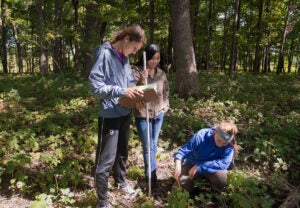 When Luther received a 10-acre land donation a couple of years ago, professor of biology Beth Lynch was puzzled. The Weigle-Roslien woodland contained an old sugar maple forest, which Lynch says is rare for Iowa. “I’m a forest ecologist, and this particular woodland represents a real enigma. In this area, if you find sugar maples and basswoods and other fire-sensitive species, they’re going to be on a steep north-facing slope, where it’s moist and protected from fire, and this one is on a flat upland. I was immediately attracted to it because it’s so strange.”
When Luther received a 10-acre land donation a couple of years ago, professor of biology Beth Lynch was puzzled. The Weigle-Roslien woodland contained an old sugar maple forest, which Lynch says is rare for Iowa. “I’m a forest ecologist, and this particular woodland represents a real enigma. In this area, if you find sugar maples and basswoods and other fire-sensitive species, they’re going to be on a steep north-facing slope, where it’s moist and protected from fire, and this one is on a flat upland. I was immediately attracted to it because it’s so strange.”
Lynch saw a great opportunity to use this unusual, never-researched land to teach her ecology students how to set up permanent research plots and how to design and carry out original, independent small-group research projects. The students spent the first few weeks of their fall ecology course staking out the plots, then conducting thorough surveys of the trees and understory within the plots. Lynch plans to contribute this data to the Ecological Research as Education Network (EREN), a collaborative project between several colleges that generates and shares publishable data.
Says senior Matthew Peterson, “I found it interesting to be a part of setting up permanent plots. I’ve never done that before, and I’ll look back on that and think it’s cool to have initiated a project.” But it’s clear that the independent small-group research is what really excited the double biology/environmental science major, who studied carbon storage in the soils of different areas of the woodland.
Learning to Think Independently
“I wanted to incorporate what I’ve learned to appreciate during my time at Luther,” Peterson says. “When you’re able to develop your own project, I think it really helps to maintain motivation—we were as interested in the results as Dr. Lynch was.”
While Peterson and his partners researched carbon storage, other students in the class studied invasive earthworm populations or the number and variety of tree species on the edges of the forest versus the interior. One group did a comparison study between the Weigle-Roslien woodland and similar forests in Minnesota, and another took a historical perspective and tried to estimate the age of the forest and answer the question of why so many sugar maples persisted there.
“One of the most important things we learned,” says senior biology major Emma Stivers, “was to consider how much we could tackle. A lot of us have been on research projects in which the baseline was laid out for us and we were just adding to the data, and all of that prioritization work had already been done for us, so this was a very valuable learning experience for me.”
“And that’s a huge part of research,” adds Lynch.
Senior biology Marissa Wales explains that another challenge was the unpredictability of outdoor research: “You come up with a question and think about what data you want and what your methods are going to be, but often when you get out in the field little things come up, even with lots of planning. Plus, when you’re in the field, things take a lot longer than in the lab, where sometimes you’re working with bacteria that have really fast generation times.”
Lynch agrees. “I think it’s a really challenging thing to learn how to ask that kind of question—how do you ask a question about systems that are so complex, have long-lived species, and change over time that you can still answer in a semester? It’s very difficult to do.” She pauses to smile at the students. “But you guys pulled it off.”
The Advantages of Learning at Luther
“One of the reasons I was really excited to come to Luther in 2001 is because of all of the land immediately around campus that’s accessible for this kind of teaching,” says Lynch. “Because we have the land, and because it’s close, we can do this kind of work.”
It’s also possible, she says, because of small class sizes. “At many colleges, there would be too many students in an ecology class to give students this kind of experience,” she explains. “But at Luther, our classes are small enough that we can do real learning, and to me, this is real learning. The kinds of things Emma and Matt and Marissa have been taking about—I didn’t teach them any of it. I created a situation where they would learn these things. I like learning to happen from the bottom up rather than saying, ‘This is what you would experience if you were to actually do this yourself.’”
Weigle-Roslien proved the ideal spot for this approach. “In past years,” she says, “I’ve had students come up with independent research projects; it’s a hard thing to do, but I think they learn a lot from doing it. This year, we started by really getting to know the forest while we set up the permanent research plots. This experience of being in those woods and looking closely worked really well. The learning that happened during those first three weeks really set them up well to do a project. Every week I said: Okay, we have some work to get done, and it’s a lot of work, but I want you to also just be here and to look around and wonder.”
About Weigle-Roslien
The Weigle-Roslien woodland, a 10.31-acre tract of land, was donated to the college by Luther emeriti professors James Weigle and Dave Roslein. Says professor of biology Beth Lynch, “Part of what this particular piece of property has to offer is that it is so different from what students are used to seeing and learning about, so I got really excited about being able to introduce them to a completely different kind of ecological community.
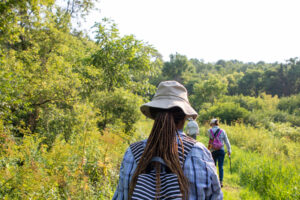 Luther has nearly 700 acres of natural areas, accessible by stepping off the main campus and directly onto the trails.
Luther has nearly 700 acres of natural areas, accessible by stepping off the main campus and directly onto the trails.
The woodlands, prairies, and river access provide an opportunity for students and community members to investigate biology, writing, art, recreation, and more. Students, faculty, and staff use the natural areas for classes, research, and recreation. The natural areas are actively managed to promote native diversity and improve the ecological health of the land, including restoring oak and oak-hickory woodlands, and converting land back into bottom land forests and prairies.
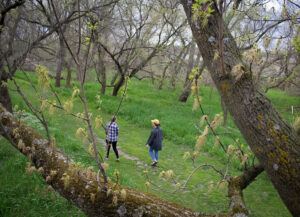
Students enjoy a walk through the trails on lower campus near the Upper Iowa River. April 19, 2017. Photo by Madie Miller.
Self-guided trail hikes
View trail maps and a Google map for your hand held device. Printed maps are located in the Union and the first floor lounge of Sampson Hoffland Laboratories.
Approximately eight miles of trails are open to students and community members for recreational and nature walk use, throughout a variety of different habitats. Grab a group of friends for a study break, clear your mind, observe your surroundings, and reconnect with nature. New benches are added along the trail each year, made by land stewardship interns. Sit with a friend to enjoy the view, bring a good book to read, or compose a few verses if you are inspired. A few common activities include:
- Spring: Spring wildflowers create a patchwork carpet in many of our woodlands and forests. Each week of spring sees another wildflower at its peak. Migratory birds arrive from warmer winter climates or use the natural areas as stopover to their summer breeding grounds. Forested trails along the river provide prime viewing and birds are easiest to see before trees leaf-out from their winter dormancy.
- Summer: Stand on the banks of the Upper Iowa River to enjoy fishing or get in the water in a canoe and kayaks rented a from student outdoor recreational services. Our 90 acres of restored tallgrass prairies are cheerful with showy wildflowers in the mid and late summer, along with butterflies and other insect pollinators.
- Fall: The topography of the Driftless Area offers a good vantage point to see the variety of native deciduous trees put on a show of fall colors. In the prairies, warm season grasses, including little bluestem and yellow Indian grass, end the growing season with their flowery plumes.
- Winter: During winter months, snow shoes can be rented from student outdoor recreational services. If you have your own skis, ski trails are groomed when conditions permit. After sunset, listen for great horned and barred owls, or look up to the night sky for constellations.
- An avid photographer? Submit your photos of Luther’s natural areas from any season to our photo contest.
- Organized trail walks: Some of our yearly trail walks include family/parents weekend, spring wildflower identification, migratory bird watching, fall colors, and star gazing. Wellness hosts an adventure race in that in some years takes place on Luther’s trails and waterways. Have an idea for an organized walk? Contact the natural areas land manager.
- Participate in ecological restoration events
Species lists: Identifying what you see
- Identification of common trees in our woods. Use the attached pdf guide and list to learn many of the common trees in the natural areas.
- Historical habitat descriptions and species lists. In 1905 Bohumil Shimek published the Plants of Winneshiek County which is a helpful resource for ecological restoration in northeast Iowa.
- Students: Field guides for plants and animals can be borrowed from the library or downloaded from the Book Shop. Visit the library to check out field guides on birds, insects, mammals, trees, wildflowers, animal tracks, and stars of the night sky.
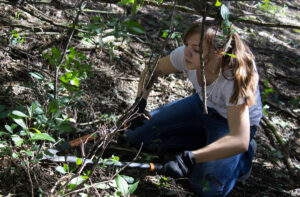
First year students work with members of Luther’s Land Stewardship crew to remove invasive Buckthorn from Hickory Ridge Woods. Sunday, September 12, 2016. Photo by Nathan Riley.
Volunteers have the power to make a difference on our natural areas. With a bit of training and equipment provided by the land stewardship team, volunteers quickly remove invasive species from a target area, pick up trash deposited in the Upper Iowa River Floodplain, or plant native trees and shrubs.
Volunteer events not only help to restore native habitats, but are great team-building opportunities. For example, the men and women’s soccer team contacted the land stewardship crew when they were interested in planning a service project at the start of their practice season—they removed buckthorn from the woods that border the athletic fields. Community members are also encouraged to participate in planned events for a chance to get out in the woods or to see how restoration work might be applied on your own land. Please contact us at Land Stewardship if you would like to be on an email list about events.
Regularly scheduled events include:
- Buckthorn Blitz (fall)—Join us to cut and treat buckthorn adults and pull seedlings. After a brief introduction to non-native, invasive European buckthorn (Rhamnus cathartica) and honeysuckle (Lonicera spp) identification, volunteers quickly find the rhythm of working with a partner, finding the next stem, and calling out for herbicide stump treatment.
- Garlic mustard pulls (spring)—Spring is a great time to get to know our oak-hickory woods and spring wildflowers, and pulling garlic mustard gives the great satisfaction of making a difference. It’s also that time of year in the Midwest when we use any excuse to get outside! Students regularly volunteer to remove garlic mustard in other local natural areas with Decorah city parks and the Iowa Natural Heritage Foundation. Biology department professors Beth Lynch and Mary Lewis (emeritus) received statewide recognition from the Iowa Natural Heritage Foundation for organization and education about garlic mustard in Decorah city parks.
- Prescribed fire (spring, fall)—Fire is a natural disturbance in our landscape applied in our prairies and woodlands for various objectives, including woody species reduction, litter consumption, and control of some invasive species. The prescribed fires, a.k.a, controlled burns, we set on campus are selected based on our objectives, with attention paid to historical disturbance regimes (e.g., how often did fire occur in a similar landscape in the past), phenology of the species that are targeted (for increase or reduction), and protection for native species that are fire intolerant (e.g., certain insects or birds need unburned locations for food and/or shelter).
About Prescribed Burns
Anyone wishing to participate in a prescribed fire MUST attend the prescribed fire training session, which is an hour session on fire behavior and prescribed burn safety. Training sessions are typically offered in the spring and fall before the start of the burn season.
- What to wear: Volunteers should wear natural materials, i.e., cotton, wool, silk) and NOT synthetics such as nylon or polyester, which melt or burn easily. Common clothing to wear are cotton jeans and t-shirts. Old tennis shoes work fine, but leather soled boots (no steel toes) are even better.
- What to bring: Water bottle for drinking. You might also want to bring: bandanas (one for smoke reduction, and another for your hair), sunglasses, carabiner to attach your water bottle to your belt loop.
- We provide: Nomex fire suits, leather work gloves, and all fire equipment, including flappers, water packs, etc.
- Participating in the burn: Before the event, respond to email that you can attend, so we know whether we have a large enough crew to safely conduct the burn. When you get to a burn, show up at the assigned meeting place. Sign in. Find a fire suit that fits. Then, suit up and grab a pair of leather gloves. The burn boss will introduce the burn unit, safety hazards, objective of the fire, and line assignments. From time to time, we need volunteers to help with maintaining safe burn breaks, especially if it’s a larger burn unit. Calls for break construction and maintenance usually occur in the weeks before the fire.
- Native prairie plant sale at the Winneshiek County farmers market in Decorah, Iowa (spring). In 2013, we started selling native prairie plants at the farmers market in May (Saturday mornings). All plants are grown from local ecotype, native seed collected from our own prairies. Plants are grown in the biology department greenhouse. Volunteers help transplant seedlings into larger pots (February and March) and on the day of sales (moving plants from the greenhouse to the market) and are available from Winneshiek County Farmer’s Market.
- Trail construction and maintenance (summer): Some summers we have trail re-routes, new trails, or trail reconstruction projects. Trail work is necessary to reduce or repair damage from erosion, regular use, connect to new natural areas, and/or make trails safer.
- Want to organize an event? Be the motivator for your class, organization, sports team, or group of friends. Activities MUST be coordinated through the natural areas land manager—we’ll direct you to projects that can be accomplished with the number of people you have and your interests. You advertise and organize your group. For most activities, we coordinate the event, provide training for your group, and equipment necessary for the work.
Our core land stewardship team is at work on the natural areas every week during the school year and full time during the summer. Contact us if you would like to join us on regular field days.
Find out about upcoming events: To be notified of upcoming events, including prescribed fire crew, email Dr. McNicoll.
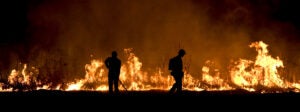 Luther’s natural areas include many remnant and restored habitats, with diverse native plant and animal communities. Many of our woodlands are relatively intact, but historically common habitats, including prairies, oak woodlands, and savannas, were lost or altered by past land use. To maintain the diversity of our existing habitats and replace those that were converted, faculty, staff, and students restore and actively steward these habitats. Activities vary from site-to-site and may include: monitoring for and removing invasive species, re-planting native species, and/or re-introducing appropriate processes such as fire.
Luther’s natural areas include many remnant and restored habitats, with diverse native plant and animal communities. Many of our woodlands are relatively intact, but historically common habitats, including prairies, oak woodlands, and savannas, were lost or altered by past land use. To maintain the diversity of our existing habitats and replace those that were converted, faculty, staff, and students restore and actively steward these habitats. Activities vary from site-to-site and may include: monitoring for and removing invasive species, re-planting native species, and/or re-introducing appropriate processes such as fire.
- Students interested in land stewardship opportunities, including internships, should contact Dr. McNicoll.
- Students interested in research opportunities related to restoration, ecology, wildlife biology, entomology, botany on Luther’s or other natural areas, please inquire with any of the following professors in the Biology department: McNicoll, Lynch, Larsen, Reding, or Baack.
Active restoration started on Luther’s lands in 1969, when biology professor Roger Knutson and his fall Ecology class started an annual project of adding small amounts of prairie seed to a former 2-acre pasture, which continued until 1980 (Aikman Prairie). Larger scale prairie plantings occurred in the late 1980s and 1990s (Anderson Prairie) and 2005 (Gateway prairie). The work of planting native habitats continues: Since 2011, Luther has replanted 13 acres of bottomland forest, 25 acres of prairie along the Upper Iowa River, and nearly 3 acres of prairie designed to research pollinator habitat.
Prairie Restoration: The college natural areas include 90 acres of restored prairies. The primary goals for these plantings are:
- Increased native diversity and habitat (plants, insects, birds, etc.)
- Opportunities for classroom use and scientific research
- Reduced soil erosion
- Sediment retention during floods
- Foster human connections to a habitat once common amidst a mosaic of forests, woodlands, and savannas in the region
To see a map highlighting the different prairies, view the map image on this page or go to the natural areas descriptions for more information.
Forest Restoration: We are lucky to have large areas of relatively intact, native dominated woods and forests. Most of our active woodland management is focused on maintaining this diversity, controlling invasive species, and where appropriate, re-introducing natural disturbances, including prescribed burns.
Follow the trails from campus to visit oak-hickory forests and woods, including Hickory Ridge Woods, Hoslett Study area (located along the Upper Iowa River), and Flying Squirrel Woods and Spilde Woods, which are part of Roslien Woods.
Lionberger Environmental Preserve (5 miles east of campus on Pole Line Road) and Weigle-Roslien Tract (15 minutes north of Decorah) are the college’s best examples of intact woodlands with fantastic wildflower displays in the spring. In these woods, we are managing for invasive species, such as garlic mustard and Japanese barberry.
Prescribed fire in our woodlands
Low intensity ground fires were a part of the historical natural disturbance regime of many of our open woodlands. Although, not all of our NE Iowa woods are adapted to fire and would be damaged by fire, so we apply it very selectively. In fall 2015, prescribed fire was introduced to Flying Squirrel Woods, as part of a research project to enhance native plant diversity and decrease European buckthorn. The west side of Hickory Ridge Woods (behind the big red barn) was also burned in fall 2015 to reduce buckthorn abundance and initiate restoration of what appears to be remnant oak savanna and prairie. A pilot project in Hickory Ridge Woods in 2009 allowed us to experiment with forest canopy thinning and spring prescribed fire (visible on the slope behind Baker Commons).
Forest plantings: In the fall 2011 and spring 2012, we planted ~14 acres of bottomland forest along the Upper Iowa River at Norski Bottoms. Nine native tree species were planted using two different planting methods: half of the area was planted with seedlings in traditional plantation rows, and half was planted using direct seeding (walnut and ash seed was sown in the fall, supplemented with oak seedlings in the spring). A mature plantation of non-native conifer and native hardwood tree species can be seen in Roslien Woods, ~50 acres planted in the 1980s to improve eroding cropland.
Want to plant a prairie or forest of your own?
Prairie and woodland plants and seed native to northeast Iowa can be purchased from several regional dealers including: Prairie Moon Nursery, Ion Exchange native plant nursery, Shooting Star native plant nursery, Iawisil native forest nursery, among others. Be sure to specify to the nursery that you want ‘local ecotype’ seed or plants to ensure you receive plants with genetics from your local area (e.g., rather than the same species, but whose seed was collected from northern Minnesota).
Managing invasive species: Invasive species are non-native species that cause economic or ecological/environmental harm. Invasive species such as European buckthorn and garlic mustard negatively impact native communities in many ways, such as decreasing the germination, growth, and flowering of native trees and wildflowers, altering food sources for native pollinators and insects, and even changing soils nutrient cycles. To make the best decisions for healthy habitats and prioritize our efforts, we consider several things:
- Which species to manage? Species are prioritized if they are known to have negative ecological effects or negative effects on humans who visit the natural areas. Using research literature as the basis, the species that we manage have caused, or are likely to cause, significant negative impacts if not removed.
- Why not just remove all non-native species? Many non-native species are not invasive. Nor are all commonly viewed ‘weeds’ the source of ecological harm. Additionally, the disturbance of removing invasive species can make a problem worse if not accompanied by appropriate follow-up measures.
- How is management prioritized? Highest priority areas are high quality native habitat—it is better to protect quality habitats now, than to try and re-build them later. Another priority includes areas with low abundance of the invasive species. For example, it is more effective to remove sub-adult buckthorn at low density than to wait 5 years and have to contend with mature buckthorn and lots of seedlings. It is also beneficial to manage areas that may be a significant seed source for adjacent native habitats (i.e., high potential for further invasion).
We use a combination of methods that take into account the life cycle of the plant, the mode of reproduction, and the most efficient means with the least side effects. This includes pulling seedlings, cutting and treating stumps with herbicide to prevent re-growth, leaf-applied herbicide in moderation, and prescribed fire.
Invasive species management is almost never a one-time treatment. We monitor areas after they have been treated, and many areas require multiple years or decades of management. In addition, once the invasive is sufficiently reduced, we may also need to supplement with native seed or plantings.
If you are in identifying or managing invasive species on your own property, including proper identification, stages for control, and species-specific best methods, the following resource offer reliable information.
Book: Invasive Plants of the Upper Midwest by Elizabeth Czarpata. 2005.
Web:
- Midwest Invasive Species Information Network (MISIN)
- Midwest Invasive Plant Network (MIPN)
- Center for Invasive Species and Ecosystem Health
Species we are currently managing are listed below. For identification and more information on these species, see the previously-listed resource links.
- Woody invasive species: European buckthorn (Rhamnus cathartica), honeysuckle (exotic Lonicera spp.), Japanese barberry (Berberis thunbergii). Common to abundant in several of our woodlands.
- Garlic mustard (Alliaria petiolata). Common to abundant in several of our woodlands.
- Wild parsnip (Pastinaca sativa). Wild parsnip is a relatively recent introduction and quickly spreading, especially along mowed roadway edges and low diversity grasslands. It is highly toxic to human skin in the presence of sunlight.
Species with varying abundance that we are also managing:
- Cypress spurge (Euphorbia cyparissias)
- Japanese hops (Humulus japonicus). Beware: Know your identification—there is a native, non-invasive vine that looks very similar!
- Japanese knotweed, Japanese bamboo, or Giant knotweed (Fallopia japonica, other scientific names also apply). This is an emerging threat along the Upper Iowa River and tributaries.
- Multiflora rose (Rosa multiflora)
- Crown vetch (Securigera varia)
- Canada thistle (Cirsium arvense)
- Reed canary grass (Phalaris arundinacea)
- Sweet clover (Melilotus alba and M. officinalis)
Species on our watch list (not present on the natural areas as of yet):
- Asian bittersweet (Celastrus orbiculatus) Beware: Know your identification—there is a native, non-invasive vine that looks very similar!
- Knapweed (Centaurea sp.)
- Siberian squill (Scilla siberica)
All of Luther’s natural areas are managed under the college’s land stewardship plan, but some areas have been allocated to various conservation easements. See a map of land protected as part of the Emergency Watershed Protection program.
Luther’s natural areas are open to students, faculty, and staff, and community members and visitors. For a safe and positive experience for all of those using Luther’s natural areas, please follow these guidelines as you enjoy the natural areas:
- Multi-use of trails: The trails are designed primarily for pedestrian use. Bikers are allowed on marked trails on a trial basis, and will continue as long as there is no conflict with other users, degradation of trails or surrounding habitat. Bikers must stay on official trails and always yield to pedestrians. We suggest not using headphones while biking, as it reduces the possibility you will notice other trail users. Horses are not allowed on the trails. No motorized vehicles are permitted on the natural areas (except authorized Luther College vehicles). Winter users: please respect skiers by staying off ski trails.
- Collection of plants, animals, or other items from the natural areas is prohibited, unless approved in writing by the natural areas land manager (and in some cases, the Land Use committee). See fishing exception.
- Pets: Well-behaved dogs are allowed in the natural areas. Clean up after pets to make sure the area is clean for all users. If your dog is prone to hunting wildlife, they must be kept on a leash. Be aware that we occasionally use herbicide to treat invasive and/or nuisance species. For larger areas being treated, a notice will be posted on our website.
- Toxic plants and critters: Problem species that are common in northeast Iowa are also present on Luther’s lands, it would be helpful to be able to identify the following species. Wild parsnip, found in several of our grasslands and other open areas, is toxic to bare skin (in the presence of sunlight) and should be avoided. Poison ivy is present at low abundance in some wooded areas. As in the rest of the county, deer ticks that carry Lyme and other transmissible diseases are in the area. Use precautions and check yourself for deer ticks (much smaller than dog/wood ticks) when done with your hike.
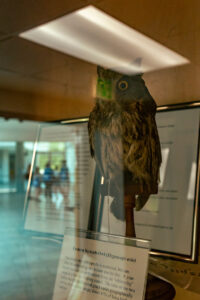
Luther Colleg Valders Building
Photgrapher: Duy Nguyen
©2023 Luther College
The Hoslett Museum of Natural History is housed in Valders Hall of Science. The Hoslett collections, supported in part by an endowment established by the Hoslett family in 1972 in honor of former Luther biology professor Sherman Hoslett, contain over 5,000 vertebrate specimens, including birds, mammals, fish, reptiles, and amphibians, and a significant collection of over 1,500 bird eggs.
The herbarium collection contains over 1,000 pressed plants. The Luther entomological research collection has over 12,000 pinned insects. Together, these collections form a rich resource on the biodiversity of Northeast Iowa and the Driftless Region for teaching, research, reference, and exhibit. Tours are available by appointment.
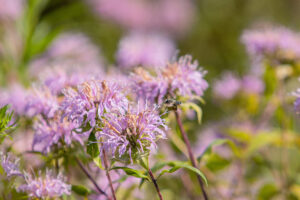
Students work on their summer research project with native bees on campus 2022.
Photo: Armando Jenkins-Vazquez
© 2022 Luther College
As certified Bee Campus USA campus, Luther College recognizes the benefit to pollinators that Luther has been providing through our sustainability and land stewardship efforts over the years. Creating and enhancing pollinator habitat on campus has been an ongoing collaboration of the Biology department, Luther College Land Stewardship, and facilities. The college land use council serves as our Bee Campus USA Committee.
Ongoing Luther College efforts to support pollinators:
- Research on Pollinator Diversity and Conservation. Numerous research projects on pollinators such as native bees, moths, and butterflies have been performed over the past 25 years by the Luther biology department.
- Landscaping with Native Plants. Many of the landscape plantings on the central campus have been converted from non-native plants to native plants over the past 20 years thanks to the efforts of our grounds crew.
- Prairie Plantings. Approximately 120 acres of native diverse tallgrass prairie habitat has been planted on campus over the past 30 years in Anderson Prairie, Gateway Prairie, Aikman Prairie, Jewell Prairie, and West River Prairie.
- Oak-Woodland Restorations. Oak woodland and oak savanna restoration efforts include brush clearing and prescribed burning to restore understory vegetation in Hickory Ridge Woods and Flying Squirrel Forest. These ongoing activities have created and enhanced areas of pollinator habitat on college lands.
- Invasive Species Control. The natural areas land stewardship crew under the leadership of our natural areas land manager removes and treats invasive species such as garlic mustard and European buckthorn from our forests. Periodic “buckthorn blitzes” that have provided hundreds of Luther students opportunities to remove invasive species on campus, which enhances pollinator habitat.
- Prescribed Burning of Native Habitats. Our prescribed burn program trains students in fire safety and fire ecology, then involves them in prescribed burns of our prairies and woodlands.
- Reducing Herbicide Use. On campus spraying of herbicides by the grounds crew in facilities has been dramatically reduced and follows strict application guidelines which minimizes exposure and areas of application.
- Home to Rusty Patched Bumble Bee. In our natural areas beyond the central campus, the Federally-endangered rusty patched bumble bee, Bombus affinis, has been found, and the mix of prairie and woodlands on the landscape make our campus an ideal home for this endangered and protected species of bumble bee.
- Honey Bees. The Luther entomology research lab maintains several honey bee hives on campus, and proceeds from the sale of honey support pollinator conservation and research efforts on campus.
- Native Plant Sale. The natural areas land stewardship program has an annual native plant sale at the local farmers market each spring, and one emphasis of this sale is to help local residents understand the importance of native plants in pollinator conservation.
- Education on Pollinators. Numerous courses on campus have pollinators as a focus or topic as part of the curriculum. Student projects often focus on pollinator diversity and ecology.
About Bee Campus USA
Bee City USA and Bee Campus USA are initiatives of the Xerces Society for Invertebrate Conservation, a nonprofit organization based in Portland, Oregon, with offices across the country. Bee City USA’s mission is to galvanize communities and campuses to sustain pollinators by providing them with healthy habitat, rich in a variety of native plants and free of pesticides. Pollinators like bumble bees, sweat bees, mason bees, honey bees, butterflies, moths, beetles, flies, hummingbirds and many others are responsible for the reproduction of almost 90 percent of the world’s flowering plant species and one in every three bites of food we consume.
For more information about Bee Campus USA, visit https://www.beecityusa.org/. For more information about the Xerces Society, visit https://xerces.org/. For information about four simple ways to help pollinators, visit https://xerces.org/bringbackthepollinators/.
For more information about Luther’s Bee Campus USA activities, contact the Luther Entomology Research lab: buglab@luther.edu.